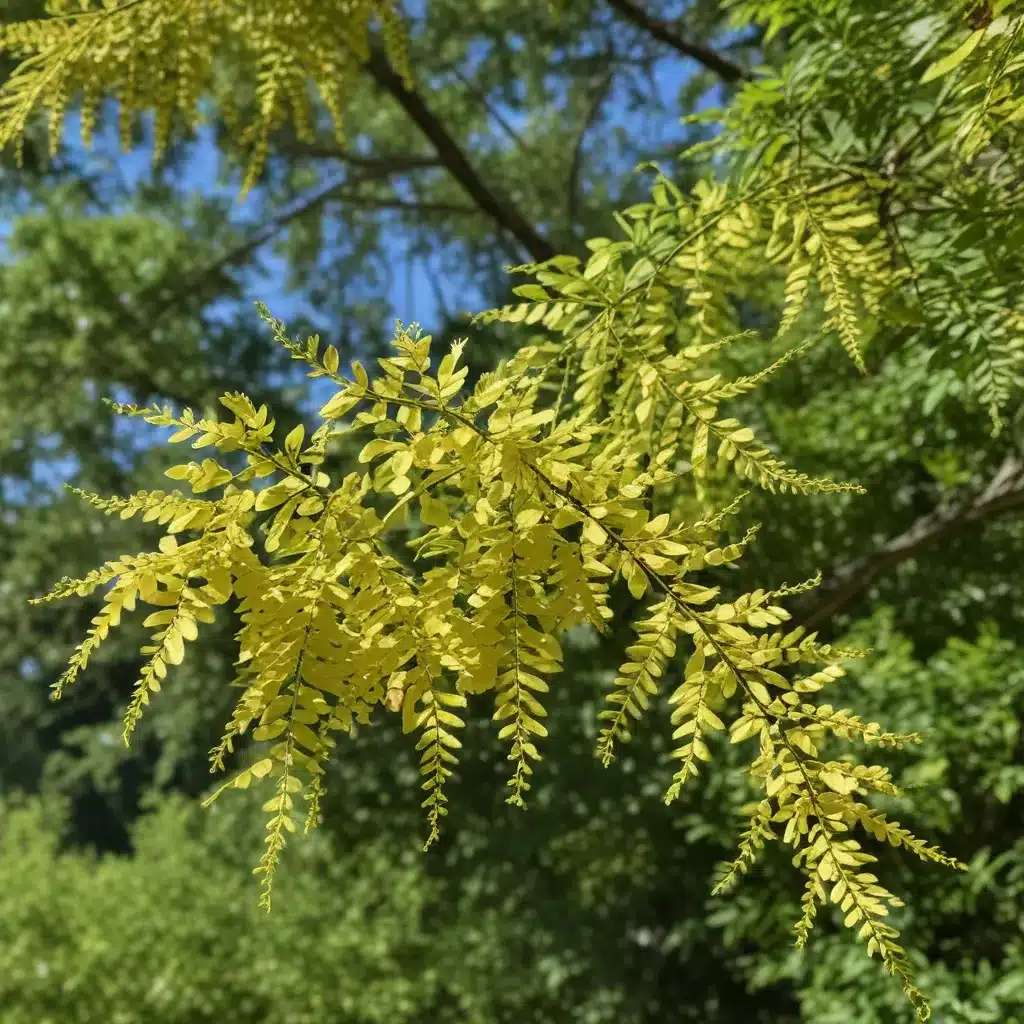
The honeylocust (Gleditsia triacanthos) is a captivating deciduous tree native to central North America, renowned for its graceful silhouette, intricate foliage, and remarkable ecological significance. As a member of the Fabaceae (legume) family, this species has evolved a unique set of characteristics that have made it a cherished addition to landscapes across the continent. Let us delve into the botanical intricacies, ecological advantages, and horticultural considerations that make the honeylocust a truly distinctive and delightful tree.
Botanical Characteristics
The honeylocust is a medium to large-sized tree, typically reaching heights of 60-80 feet (18-24 meters) and a spread of 40-70 feet (12-21 meters) at maturity. Its bipinnately compound leaves are a defining feature, creating a delicate, fern-like appearance that dances gracefully in the breeze. These leaves are arranged alternately along the branches and feature numerous leaflets, often numbering in the dozens. The foliage emerges in spring with a vibrant green hue, transitioning to a stunning golden-yellow in autumn before dropping to reveal the tree’s intricate branching structure.
The bark of the honeylocust is another noteworthy characteristic, developing a unique ridged and furrowed texture with age. The trunk and larger branches are often adorned with sharp, branched thorns, a defensive adaptation that deters herbivores and adds to the tree’s distinctive character. These thorns can reach lengths of up to 8 inches (20 cm) and are a testament to the honeylocust’s evolutionary resilience.
The honeylocust’s flowering and fruiting habits are equally captivating. In late spring or early summer, the tree produces small, greenish-white flowers in clusters, which eventually give way to long, flat seed pods that can reach up to 12 inches (30 cm) in length. These pods, often referred to as “honey locusts,” are the source of the tree’s common name and are a vital food source for wildlife.
Ecological Significance
The honeylocust’s remarkable adaptability has allowed it to thrive in a variety of environments, from moist, well-drained soils to drier, more challenging conditions. Its deep, extensive root system and tolerance for drought, salt, and poor soil make it a resilient choice for urban and suburban landscapes, where it can flourish in the face of environmental stressors.
One of the honeylocust’s most notable ecological contributions is its role as a nitrogen-fixing plant. Through a symbiotic relationship with soil-dwelling Rhizobium bacteria, the tree is able to convert atmospheric nitrogen into a form that can be readily absorbed by its roots, enriching the surrounding soil. This process enhances the overall fertility of the ecosystem, benefiting both the honeylocust and the other plants that share its habitat.
The honeylocust’s ecological significance extends beyond its soil-enriching capabilities. Its nectar-rich flowers provide a valuable food source for pollinators, such as bees, butterflies, and hummingbirds, contributing to the overall biodiversity of the local environment. Additionally, the tree’s seed pods and foliage serve as an important food source for a variety of wildlife, including small mammals, birds, and even some large herbivores.
Horticultural Considerations
The honeylocust’s adaptability and visual appeal have made it a popular choice for landscaping and urban forestry applications. When selecting and planting a honeylocust, it’s essential to consider the species’ specific needs and preferences to ensure its long-term success.
In terms of planting and cultivation, the honeylocust thrives in full sun exposure and well-drained, slightly acidic soils. It can be grown from seed, but nursery-grown seedlings or cultivars are often the preferred choice for landscape projects, as they offer more consistent growth patterns and reduced risk of disease or pest infestations.
One of the honeylocust’s most valuable landscape applications is as a shade tree. Its open, airy canopy allows for the passage of dappled sunlight, creating a pleasant, filtered shade that is ideal for use in parks, gardens, and along streets. Additionally, the tree’s fast growth rate and drought tolerance make it a resilient choice for urban environments, where it can help mitigate the effects of heat islands and provide much-needed greenery.
Gardeners and landscape designers have also embraced the honeylocust’s cultivars and varieties, each with its own unique characteristics. For example, the ‘Sunburst’ cultivar offers a striking golden-yellow foliage that adds a vibrant touch to any landscape, while the ‘Skyline’ cultivar is prized for its pyramidal form and reduced thorniness, making it a more user-friendly option for residential and commercial settings.
Historical and Cultural Associations
The honeylocust’s origins can be traced back to the central regions of North America, where it was an integral part of the native ecosystem for centuries. Indigenous peoples, such as the Osage and Caddo tribes, recognized the tree’s multifaceted utility, using its wood for tool-making, its bark for medicinal purposes, and its seed pods as a food source.
Over time, the honeylocust has also gained symbolic significance in various cultures. In some Native American traditions, the tree was seen as a representation of strength, resilience, and the cycle of life, with its thorns symbolizing the challenges faced along the journey and its regenerative capabilities embodying the idea of renewal and growth.
Today, the honeylocust continues to be a beloved and widely-cultivated tree, with its unique characteristics and ecological benefits making it a valued addition to landscapes and urban environments across the continent. Whether admiring its graceful silhouette, delighting in its dappled shade, or appreciating its role in supporting local biodiversity, the honeylocust remains a true delight for all who encounter it.
To learn more about the honeylocust and other remarkable tree species, be sure to visit TriCounty Tree Care, where our team of experts is dedicated to providing comprehensive tree care solutions and promoting the health and vitality of the urban forest.


